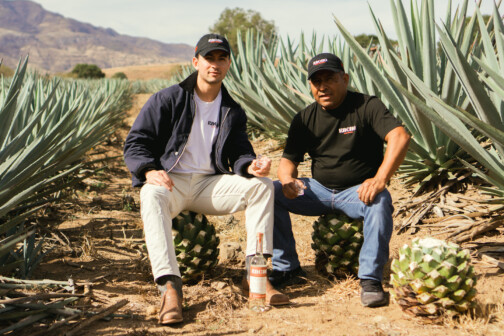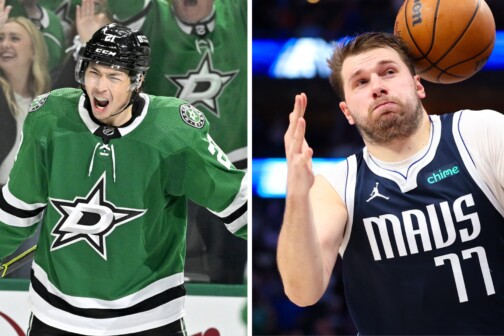Outside Ten50 BBQ in Richardson, the smell of smoked meats hung in the air on a hot day in June. Dozens were lined up during the lunch hour to order heaping trays of smoked brisket, turkey, and pork before heading inside.
A few weeks ago, UT Dallas professor Jeremiah Gassensmith brought his students to Ten50 for a tasting for a class called the History and Science of Barbecue.
Gassensmith usually keeps himself busy with an impressive day job. He runs the Gassensmith Lab at the university, where his research focuses on how virus particles interact with organic and solid-state chemistry. One of his lab’s most recent research projects involves delivering vaccines through a puff of gas.
When he’s not in the lab, he’s a self-proclaimed backyard barbecue chef. He taught himself how to cook out of curiosity, though he says sometimes it was out of necessity. He grew up in Indiana, where most dinners consist of meat and potatoes.
“Most of my family, I love them, but they’re not great cooks,” he says.
He says he often found himself looking for different cuisines outside of his community. When he was living in the Midwest, Gassensmith says he found the best barbecue in Black communities.
“It didn’t really permeate very far out of those communities,” he says. “It also wasn’t a place I frequented. When I got it, it was good, and I loved it, but it wasn’t something we could eat a lot of the time.”
Gassensmith says he was determined to “appropriate” the state’s barbecue culture when he got to Texas with his wife. He bought the cheapest smoker he could find, so cheap that he had to wrap it in thermal insulation to keep the heat inside. He took advantage of what he could and used it as a way to teach himself how to smoke meat.
Chemistry and barbecue have always gone hand-in-hand, Gassensmith says, but he didn’t fully appreciate the link until after he started smoking. Unlike cooking on a stovetop, which is essentially heating food on top of something hot, barbecue involves closely monitoring thermodynamics and reactions.
“It was advanced chemistry,” he says. “It was the sort of thing that makes sophomores really upset when they have to learn it.”
Barbecuing and smoking involve watching how heat affects the meat. The temperature and length of time meat is smoked changes the taste and texture. Rendering fat, for example, is more than just putting a fatty piece of meat on a hot pan. Rendering fat means destroying cell membranes: if it’s too hot, the fat will surely melt, but all the proteins will fry up and burn, and it’ll taste bad. To render fat correctly, it must be done at a low temperature to control the reaction.
Barbecuing is a Maillard reaction, or a chemical reaction between proteins, fats, and sugars that cause the browning of the meat. Maillard reactions are also found in whiskeys, bread, toffee, and roasted peanuts.
“You have to access this narrow range of chemistry with your temperature, and that chemistry takes a while to happen,” he says. “It’s literally waiting for proteins to unfold, and that process goes very slowly if you want them to unfold in just the right way.”
Brisket should fall apart—that’s usually a good sign the right chemical reactions took place. Brisket and pork shoulder, two of the most popular smoked meats, come from heavily used parts of an animal. When cooked incorrectly, the meat turns out chewy and tough.
Cooking the meat slow and low breaks down collagen, which looks like three strands of twisted yarn. When heat is applied—ideally between 160 to 180 degrees Fahrenheit, Gassensmith says—collagen loosens and melts, and it can bind with water to keep the meat moist. Too little heat results in chewy meat, and too much heat means the collagen tightens and makes the meat dry. Dry brining the meat with salt for a few hours can help with this; salt can “wedge” itself into the collagen strands, keeping them open for more water to be absorbed.
When Gassensmith started smoking his own brisket, he approached it the way he would any experiment. He determined the most important variables to see where adjustments needed to be made. In this case, the most important variables are temperature, meat quality, and time. His go-to is a 10 to 15-pound prime cut brisket. He uses multiple thermometer probes to monitor the temperature, which can vary based on the size of the meat.
He also sprays his meats with water as they’re smoking. Smoke binds to water and helps give barbecued meat its signature smoky taste. It also keeps the meat moist, but only if everything else has been done correctly: meat has been brined, collagen is loose, and the temperature is consistent. Gassensmith admits, though, that chemistry isn’t all that goes into barbecuing.
“It’s an art,” he says. “Every piece is going to be different. You can apply the scientific method only so far.”
During his class, Gassensmith asked his students to read Black Smoke: African Americans and the United States of Barbeque by Adrian Miller, and Smokelore: A Short History of Barbeque in America by Jim Auchmutey. Both books explore the origin of barbecue in this country.
During the colonial era, European settlers arriving in the Americas observed the Taino people of the Caribbean using a wooden structure called a barbacoa for slow-cooking meat over a fire pit. The term “barbecue” originates from the Taino word “barbacoa.”
“[Barbecue] was propagated in the United States by European immigrants,” Gassensmith says. “To understand how that spread and evolved requires you to understand a lot about the history of Black migration in the United States.”
In the South, enslaved people were skilled in smoking and pit-roasting. They played a crucial role in shaping southern barbecue traditions. They introduced new flavors, spices, and methods of cooking that became integral to the development of American barbecue.
In Texas, beef is the star of barbecue. But as Black communities migrated north, pitmasters applied their cooking knowledge to other meats, like pork and chicken. Barbecue techniques were influenced by local flavors, even down to the sauces. (Carolina barbecue sauces usually have a vinegar base, while Kansas City barbecue sauce is sweet and spicy.) The result is regional barbecue styles all over the country, such as Memphis, Carolina, Kansas City, and Alabama. Each has its own story and unique history.
“Since barbecue is just this incredibly uniquely American dish, I thought it was a great way to teach American history was through food,” he says.
Gassensmith’s Barbecue Tips
Get a great—not just good—cut of meat
Barbecue starts with a solid base, and that means three ingredients: salt, pepper, and a dang good cut of meat. For brisket, Gassensmith uses prime, which means ample amounts of fat are marbled in the meat. “You can’t hide behind lower quality cuts of meat,” Gassensmith says. “Do yourself a favor and get a nice cut.”
Use water to cool it down and develop a crust
Gassensmith prefers using water while smoking the meat. A spritz helps keep the meat juicy and gives it a smoky crust, because smoke likes to bind to water. It also helps regulate the temperature of the meat.
Closely monitor the temperature
Gassensmith uses multiple thermometers when he smokes meat. He uses a six-probe thermometer, but at least two should do the job, he says: one thermocouple sensor inside the smoker and a quick read thermometer in the middle of the piece of meat. The thermocouple should read around 250 degrees Fahrenheit for brisket and 300 degrees Fahrenheit for pork.
After it’s done, resting will help the brisket cook a little bit more help and further render fat or break down collagen, Gassensmith says, but it doesn’t help soak up any juices.
Author







